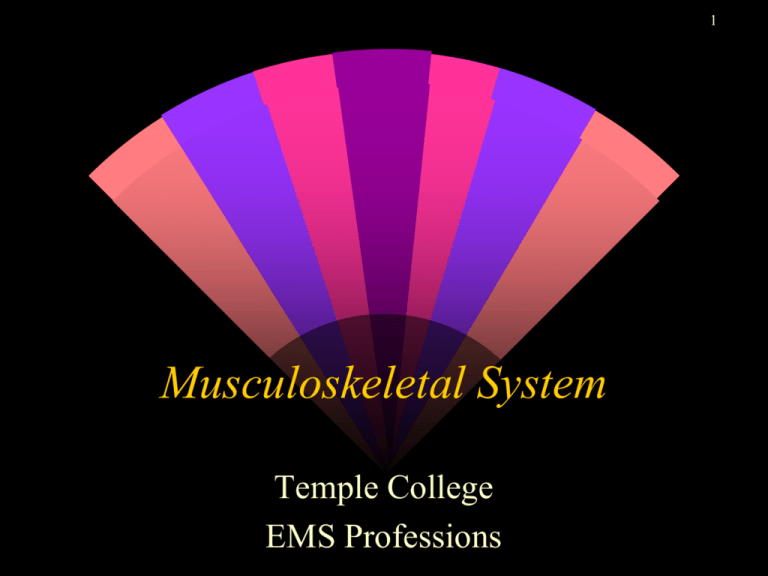Bleeding and Shock
advertisement

1 Musculoskeletal System Temple College EMS Professions Musculoskeletal System Bones Muscles Cartilages Tendons Ligaments 2 Skeleton Support against gravity Movement Protection Production of blood cells Storage of calcium, phosphorus 3 Skull Cranium • • • • Frontal Parietal Temporal Occipital Face • • • • Mandible Maxilla Zygoma Nasal bones 4 Spinal Column Cervical: 7 vertebrae Thoracic: 12 vertebrae Lumbar: 5 vertebrae Sacrum: 5 vertebrae (fused) Coccyx: 4 vertebrae (fused) 5 Thorax 12 pairs of ribs Sternum Protects heart, lungs 6 Pelvis Bony ring Two innominate bones, each made of 3 fused bones • Ilium • Ischium • Pubis 7 Lower Extremity Femur (largest bone in body) Patella (knee cap) Tibia (shin bone) Fibula Tarsals Metatarsals Phalanges 8 Upper Extremity Shoulder girdle • Scapula • Clavicle Humerus Radius Ulna Carpals Metacarpals Phalanges 9 Muscles Maintain posture, allow movement 3 types: • Skeletal (Striated) • Smooth (Involuntary) • Cardiac 10 Skeletal Muscles Voluntary muscles Attach to bones by tendons that cross joints Shortening of muscle moves joint 11 Smooth Muscles Carry out involuntary movements Located in walls of: • • • • GI tract GU tract Respiratory tract Blood vessels 12 Cardiac Muscle Found only in heart Automaticity Can initiate own contractions without external stimulation 13 Joints Joining points of bones Bone-ends covered with cartilage Ligaments connect bone-to-bone Inner surface of joint capsule lined with synovial membrane • Produces synovial fluid • Lubricates joint 14 15 Extremity Trauma Temple College EMS Professions Fracture Break in bone’s continuity 16 Fracture Causes Direct force Indirect force Twisting forces (torsion) Diseases of bones (pathological fractures) • Osteoporosis • Tumors 17 Open vs. Closed Fractures Closed = skin over fracture site intact Open = break in skin over fracture site • Bone ends do not have to be exposed • Small opening in skin communicating with fracture site = open fx • Open fractures more serious due to external blood loss, possible infection 18 Fractures One of the most important things we do in EMS is prevent closed fractures from becoming open ones 19 Fracture Types Transverse: fracture is at 90o angle to shaft Oblique: fracture is at an angle other than 90o to shaft Spiral: fracture coils through shaft of bone like a spring 20 Fracture Types Impacted: bone ends driven into each other Comminuted: bone broken into > 3 pieces 21 Fracture Types Greenstick • Shaft of bone not completely broken • Compressed on one side, splintered outward on other • What group of patients does this type of fracture occur in? 22 Fracture Signs Deformity Tenderness • Usually point tenderness • Overlies fracture site Inability to use limb • Reliable sign of significant injury if present • Reverse is not true 23 Fracture Signs Swelling, ecchymosis Exposed fragments Crepitus • Grating of bone ends • May be heard or felt • Do NOT actively seek 24 Dislocation Displacement of bones from normal positions at joint 25 Dislocation Signs Deformity Swelling, ecchymosis about joint Pain/tenderness in joint Loss of motion usually perceived as “locked” joint 26 Sprains Partial, temporary dislocations Result in tearing of ligaments Bone ends NOT displaced from normal positions 27 Sprain Signs Tenderness Swelling, ecchymosis Inability to use extremity No deformity 28 Sprains Degree of joint dislocation at time of injury cannot be determined during exam Extensive damage to neural or vascular structures may have occurred 29 Strains “Muscle pull” Injury to musculotendenous unit Pain on active motion Pain not present on passive motion 30 Assessment Perform initial (primary) assessment Locate, treat life-threats Assess for injuries of head, chest, abdomen, pelvis Assess distal neurovascular function 31 Assessment With exception of pelvic, possibly femur fractures, orthopedic injuries are NOT lifethreatening. Do NOT let spectacular orthopedic injury distract you from ABCs It’s the unobvious things that kill patients! 32 Assessment Evaluation must ALWAYS be done of distal neurovascular function. • • • • • Pulse Skin color Capillary refill Sensation Movement 33 Management Splinting • Prevents further movement at injury site • Limits tissue damage, bleeding • Eases pain 34 Management When in doubt SPLINT It is difficult to differentiate fractures, dislocations and sprains 35 Principles of Splinting Do NOT move patients before splinting unless patient is in danger Remove clothes to allow inspection of limb Note, record distal neurovascular function before, after splinting 36 Principles of Splinting Cover wounds with dry, sterile compression dressings Fractures: splint joint above, below fracture Dislocations: splint bone above, below joint 37 Principles of Splinting Minimize movement Support injury until splinting completed Pad splint to avoid local pressure 38 Principles of Splinting Angulated fractures • Realign before splinting • If resistance, pain encountered stop, immobilize as is Dislocations • Splint as is unless circulation compromised • Attempt to reposition once to restore pulse • If resistance, pain encountered stop, immobilize as is 39








